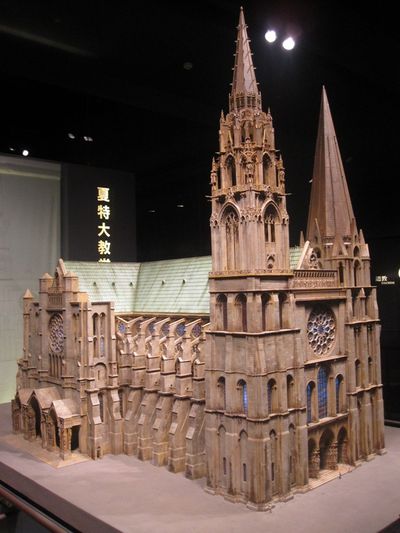Chartres Cathedral: Difference between revisions
imported>Chunbum Park No edit summary |
imported>Chunbum Park No edit summary |
||
| Line 1: | Line 1: | ||
{{subpages}} | {{subpages}} | ||
{{Image|Chartres Cathedral front view.png|right|350px|The front of the cathedral at Chartres.}} | |||
'''Chartres Cathedral''' (''Cathédrale Notre-Dame de Chartres'') is a great [[cathedral]] in [[Chartres]], [[France]]. It was built between 1193 and 1250 in the [[Gothic architecture|Gothic architectural style]] over the burned ruins of an ongoing project to modernize a previous wood-roofed [[Romanesque architecture|Romanesque]] church. The church was the center of [[Mariolatry]] in France as it housed a gift acquired from [[Constantinople]] by [[Charles the Bald]] that was known to be the tunic worn by [[Virgin Mary]] at [[Jesus]]'s [[Nativity of Jesus|nativity]]. The new facade and the Romanesque choir survived the fire, which befell on the surrounding large part of the town on June 10, 1194, and along with them the tunic, which was preserved in the crypt below the choir. The priests explained this to the townspeople as Mary's wish to be reinstalled in even greater facade, and the constructions started anew right away amidst the rubbles to fulfill her wish. | |||
{{Image|Model of Chartres Cathedral.jpg|right|400px|A detailed model of the Chartres Cathedral at the Museum of World Religion in [[Taipei]].}} | {{Image|Model of Chartres Cathedral.jpg|right|400px|A detailed model of the Chartres Cathedral at the Museum of World Religion in [[Taipei]].}} | ||
Revision as of 18:01, 23 October 2011
The front of the cathedral at Chartres.
Chartres Cathedral (Cathédrale Notre-Dame de Chartres) is a great cathedral in Chartres, France. It was built between 1193 and 1250 in the Gothic architectural style over the burned ruins of an ongoing project to modernize a previous wood-roofed Romanesque church. The church was the center of Mariolatry in France as it housed a gift acquired from Constantinople by Charles the Bald that was known to be the tunic worn by Virgin Mary at Jesus's nativity. The new facade and the Romanesque choir survived the fire, which befell on the surrounding large part of the town on June 10, 1194, and along with them the tunic, which was preserved in the crypt below the choir. The priests explained this to the townspeople as Mary's wish to be reinstalled in even greater facade, and the constructions started anew right away amidst the rubbles to fulfill her wish.

A detailed model of the Chartres Cathedral at the Museum of World Religion in Taipei.